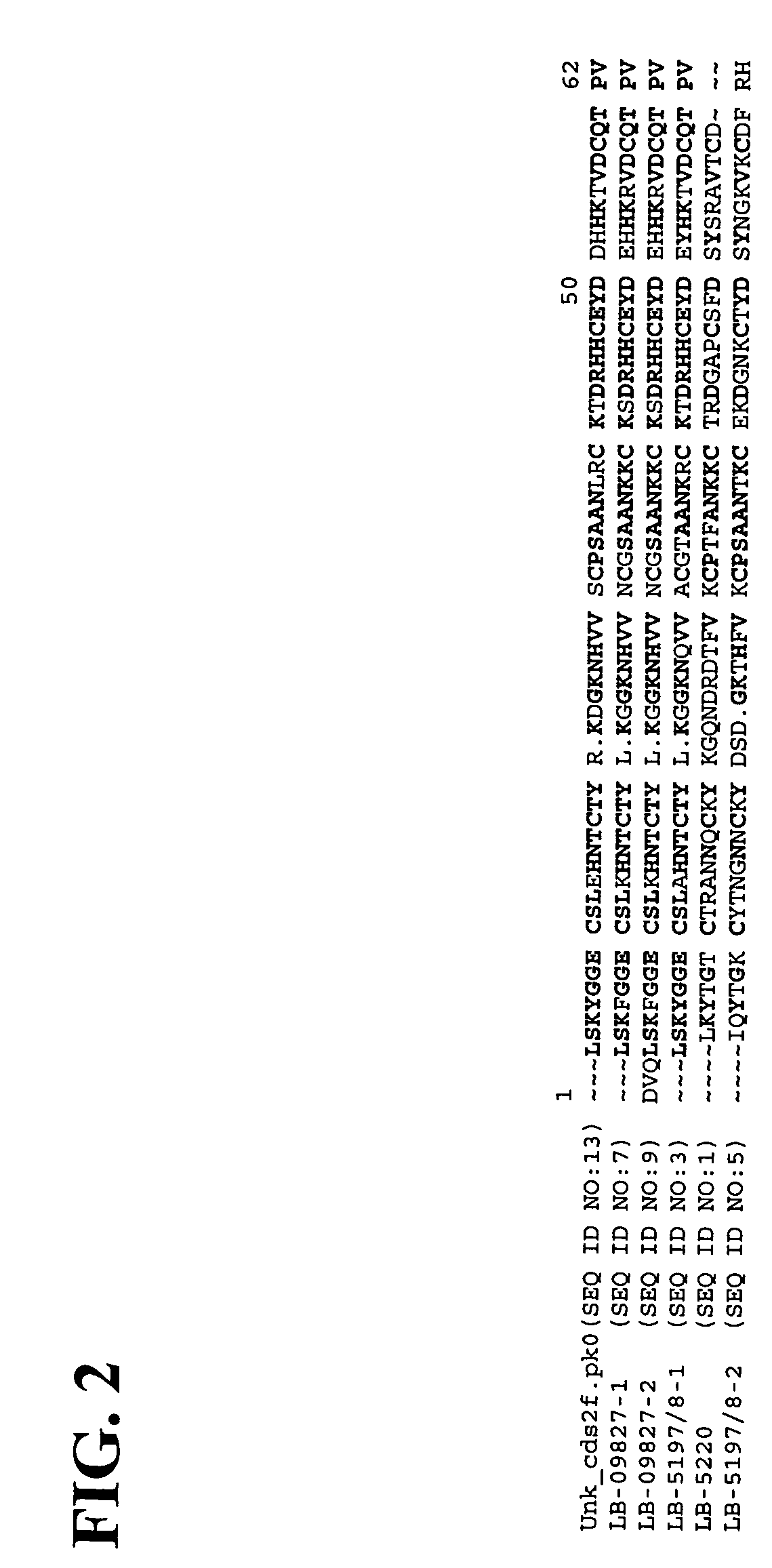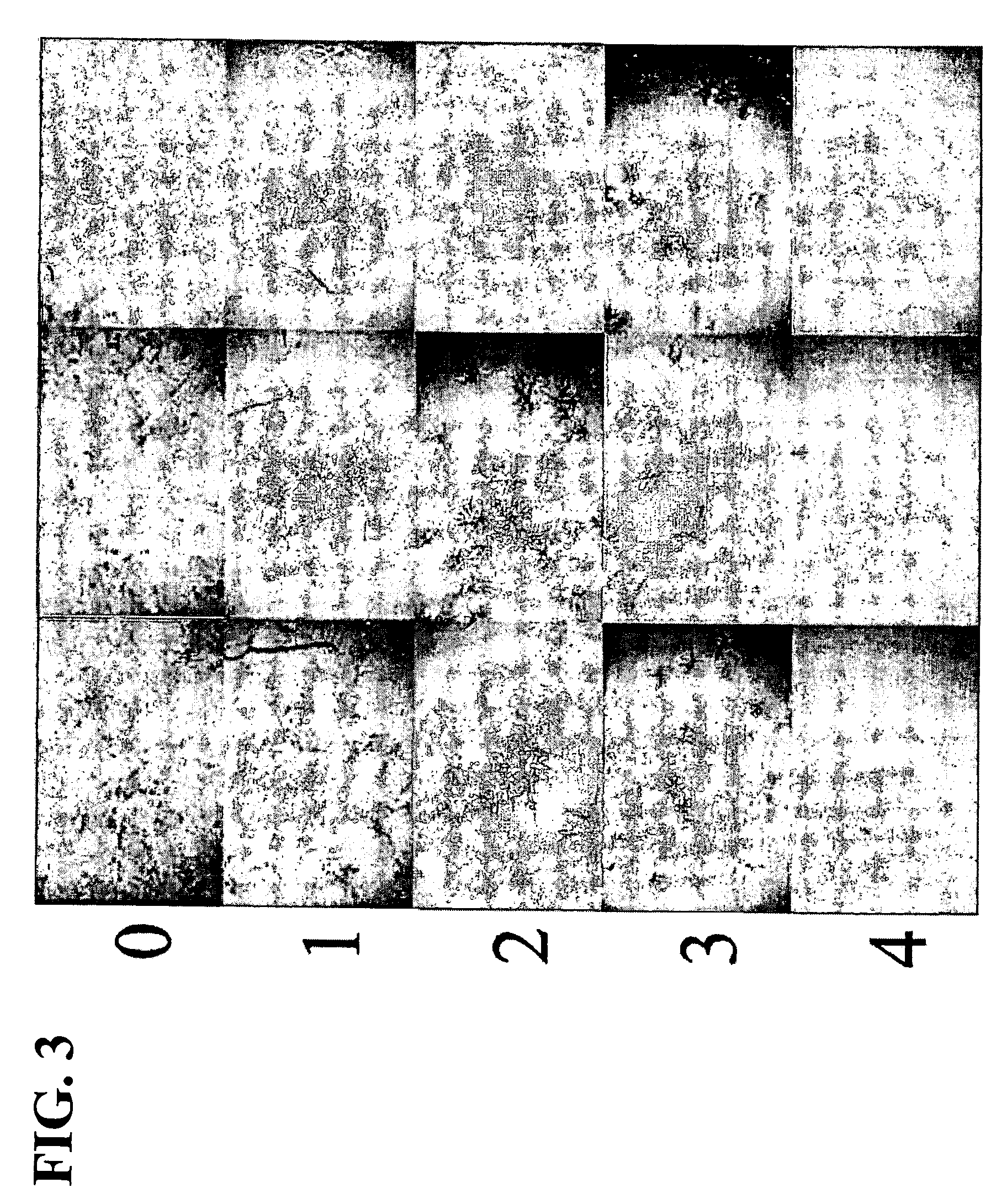Antifungal polypeptides
a polypeptide and antifungal technology, applied in the field of antifungal polypeptides, can solve the problems of increasing the cost of farmers, limiting agricultural productivity, and huge losses of marketable food, fiber and feed, and achieve the effect of increasing the resistance of the pathogen
- Summary
- Abstract
- Description
- Claims
- Application Information
AI Technical Summary
Benefits of technology
Problems solved by technology
Method used
Image
Examples
example 1
Isolation of Antifungal Polypeptide LBNL-5220 (SEQ ID NO:1)
[0141]An environmental sample was collected from a geothermal mud pool (GPS data: 54°26′256″×160°08″385″) located in the Kronotsky National Park in Kamchatka, Russia. The organism, denoted herein as K01-17A5, that produced the antifungal polypeptide LBNL-5220, was isolated from diverse colonies that grew on potato dextrose agar using isolation techniques and media as published earlier (Hunter-Cevera, J. C. and Belt, A. 1999. Isolation of Cultures, Manual of Industrial Microbiology and Biotechnology, Chapter 1, pp. 3-20). The molecular-level characterization, based on whole-cell fatty acid methyl ester (FAME) analysis and on sequencing of the D1 / D2 domains of the large subunit ribosomal RNA-coding genes, was confirmed by classical phenotype-based identification. The strain was identified as the ascomycetous fungus Penicillium simplicissimum (Oudemans) Thom (syn. P. janthinellum Biourge).
[0142]A designed set of specific growth...
example 2
Isolation of Antifungal Polypeptides LBNL-5197 / 8-1 and LBNL-5197 / 8-2 (SEQ ID NOs:3 and 5) and LBNL-09827 (SEQ ID NOs:7 and 9)
[0150]The two distinct strains of another organism, denoted herein as K01-17A2 and K01-17A4, that produced the antifungal polypeptides LBNL-5197 / 8-1 and LBNL-5197 / 8-2 (SEQ ID NOs:3 and 5), respectively, were isolated from an environmental sample that was collected as in Example 1. The organisms were selected from diverse colonies that grew on potato dextrose agar. The molecular-level characterization of the strains, based on whole-cell fatty acid methyl ester (FAME) analysis and on sequencing of the D1 / D2 domains of the large subunit ribosomal RNA-coding genes, was confirmed by classical phenotype-based identification. The two organisms were identified as strains of the ascomycetous fungus Penicillium miczyinskii Zaleski (syn. P. soppi Zaleski).
[0151]A designed set of specific growth conditions, i.e., nutrient content, temperature, pH, incubation time, aeratio...
example 3
Antifungal Activity Assays
[0158]The antifungal activity of the polypeptides of the invention against the fungal pathogens Fusarium verticillioides (FVE), Colletotrichum graminicola (CGR), Fusarium graminearum (FGR) and Diplodia maydis (DMA) was assessed using a standard plate assay. Silica gel stocks of each fungus were stored at −20° C. prior to use.
Preparation of Cultures for Spore Production
[0159]Cultures of FVE were prepared using V8 agar plates. FGR, CRG, and DMA cultures were prepared using ½× oatmeal agar. Media recipes are provided below.
[0160]Specifically, tubes containing silica-gel fungal stocks stored at −20° C. were briefly flamed, and approximately 5 crystals were sprinkled onto the agar surface. 2-3 plates of each fungal isolate were prepared. The newly plated cultures were stored in a plastic box in the dark at room temperature to prevent the cultures from drying out. New cultures were prepared every other week to maintain a consistent supply of spores.
Spore Preparat...
PUM
| Property | Measurement | Unit |
|---|---|---|
| temperature | aaaaa | aaaaa |
| temperature | aaaaa | aaaaa |
| pH | aaaaa | aaaaa |
Abstract
Description
Claims
Application Information
 Login to View More
Login to View More - R&D
- Intellectual Property
- Life Sciences
- Materials
- Tech Scout
- Unparalleled Data Quality
- Higher Quality Content
- 60% Fewer Hallucinations
Browse by: Latest US Patents, China's latest patents, Technical Efficacy Thesaurus, Application Domain, Technology Topic, Popular Technical Reports.
© 2025 PatSnap. All rights reserved.Legal|Privacy policy|Modern Slavery Act Transparency Statement|Sitemap|About US| Contact US: help@patsnap.com



